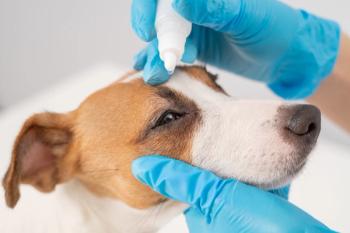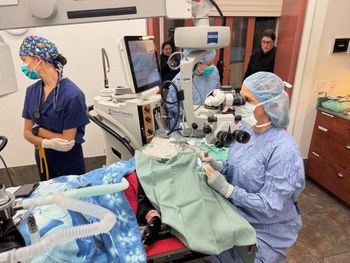
- dvm360 March 2022
- Volume 53
- Issue 3
- Pages: 18
Ophthalmic examinations should not be complicated or expensive
The ins and outs of performing ophthalmic examinations including tips on the necessary equipment, observation techniques, and beyond.
An ophthalmic examination should not be a scary experience. Although the interpretation of the findings may sometimes be challenging, the examination itself follows a logical, anatomical order. Furthermore, it does not require expensive equipment. In fact, the most important items required are nonophthalmic in nature: a room that can be darkened; a strong source of focal light, such as a Finoff transilluminator; and a magnifying loupe. You will need an ophthalmoscope to examine the patient’s fundus and a tonometer to diagnose and monitor glaucoma and uveitis patients. Other than that, all you need is a couple test strips (Schirmer tear test strips to measure tear production and fluorescein stain to diagnose corneal ulcers), a couple topical solutions (topical anesthesia and tropicamide solution to dilate the pupil), and fine forceps and/or swabs to evert the eyelids.
Remember, as with any other system and organ, one should pay particular attention to the patient’s signalment. Numerous ocular diseases may be breed- or age-related, particularly in dogs. Since many ophthalmic disorders may be manifestations of systemic or neurological diseases, a general history should be taken, and a comprehensive physical and neuro-ophthalmic examination should be conducted.
Observation
The patient should be observed as they walk into the room, as this is an unfamiliar environment that may highlight visual deficits, which will be further evaluated later. Then regard the patient from a distance without touching it (as this may cause squinting), and ask yourself the following questions:
- Are both eyes open normally? Is there squinting or excessive blinking, indicating pain?
- Are the eyes of normal size and position? Determine whether the eye is protruding (exophthalmos) or enlarged (buphthalmos) (Figure 1), and whether the pupils are of equal size.
- Determine whether eyelid conformation is normal. Do you detect eyelid inversion (entropion) or eversion (ectropion) (usually of the lower lid)(Figure 2)? Is there visible prolapse of the upper or third eyelid?
- Is there evidence of discharge? If so, what is its nature?
The orbital area is then palpated to detect any fractures, abnormal swellings, etc. Use the opportunity to press on the globe through the upper lid. This serves both as a retropulsion test, which indicates the presence of a mass behind the globe (Figure 1), and to proptose the third eyelid, allowing inspection of its outer surface. Remember that this is not an effective way of evaluating intraocular pressure.
Grossly inspect the eyelids. Carefully examine the skin and look for discharge and signs of dermatological disorders, such as dermatitis, alopecia, scaling, swelling, crusting, ulceration, etc. Slightly evert the eyelids to visualize the conjunctiva lining the lids and the 2 punctas. Use the opportunity to test the blink reflex in response to touching of the skin around the eye. Continue by examining the conjunctiva lining the globe and the cornea surface.
Testing vision and pupillary light reflexes
Assessment of vision and the pupillary light reflex (PLR), and workup of a blind patient, are described in detail in the February 2020 issue of this publication. Briefly, vision is usually evaluated by evoking the menace response with a threatening hand wave and observing a blink response. Remember that this is a cortical response, not a reflex. Therefore, it may be absent in young animals. Additional reasons for a false negative response include facial nerve paralysis (to be ruled out by testing the blinking reflex) and the patient’s mental state.
Conversely, the test may be affected by false positive results. Therefore, be sure to cover the untested eye, as it may trigger a response (Figure 3), and avoid touching the eyelashes/hair of the patient or generating air currents. These can be prevented by making the threatening gesture behind a clear plastic shield.
Vision can also be assessed using an obstacle course. You should be consistent in the obstacle course you construct, and make sure it can be navigated by normal animals. Test the patient in light and dim conditions, as this may aid in the detection of hereditary outer retinal degeneration, which often affects night vision in early stages.
Next, dim the lights and observe the dilation of both pupils. Use a dim light and stand at a distance so you can visualize both pupils simultaneously, using the tapetal reflection. The tapetal reflection also serves to highlight any ocular opacities (by means of retroillumination), particularly in the lens or vitreous. Finally, use a bright light to evoke the PLR. If one of the pupils does not react to light, or if it cannot be visualized (eg, in cases of severe corneal edema or hyphema), the consensual PLR should be checked. Alternatively, check the dazzle reflex. Like the PLR, this is a subcortical reflex and is observed as a bilateral, partial blink in response to a bright light (Figure 4).
Examining the outer surfaces of the eye
The rest of the examination is continued in the dark, using magnification and a focal light source, as the anterior structures of the eye are examined in an anatomical order.
Begin by evaluating the eyelids, carefully observing the eyelid margin. In a normal animal, you should see the entire margin in close contact with the globe. Lack of contact may be due to ectropion (drooping lid). On the other hand, if you cannot see the margin, or parts of it, the lid may be everted (entropion) (Figure 2). Eyelash abnormalities may be better visualized if the lid is slightly retracted. Aberrant dark eyelashes can then be highlighted against the background of the white conjunctiva. Surgical treatment of eyelid diseases is discussed in the November 2020 issue of this publication.
Next, examine the conjunctiva lining the inner aspect of the eyelids and globe for change in color, congestion, edema, prominent vessels, masses, thickening, discharge, moistness, or subconjunctival hemorrhage (Figure 5). Don’t forget the conjunctiva lining the third eyelid. The outer aspect of the third eyelid may be examined by pressing on the globe, causing third eyelid elevation. The inner aspect of the third eyelid margin may be examined after application of topical anesthetic and eversion of the lid with fine forceps. Look for foreign bodies or hyperplasia of lymphatic follicles.
Finally, examine the cornea. Normally, the cornea is smooth and transparent. Note decreased transparency due to edema, pigmentation, vascularization, cellular infiltration, lipid or mineral deposition, or fibrosis (Figure 6). Look for surface irregularities due to ulceration, perforation and iris prolapse, granulation tissue, or corneal bullae. Estimate the corneal diameter. An enlarged diameter suggests glaucoma, whereas a reduced diameter indicates a phthisical or microphthalmic eye.
Intraocular examination
In normal eyes, the aqueous humor should be clear. Look for any opacities or masses, such as blood, fibrin, hypopyon, aqueous flare, luxated lens, persistent pupillary membranes, iris cysts, or vitreous strands (Figure 7). Also evaluate the depth of the anterior chamber (best visualized from the side), as it may be increased or decreased in various intraocular diseases.
Next, look for alterations in pupil shape, which may be due to iris adhesions, atrophy, hypoplasia, or coloboma. Changes in the color of the pupil may indicate cataract, vitreous/retinal hemorrhage, or retinal detachment. The size of the pupil may be altered in uveitis, glaucoma, and retinal or neurological diseases. Continue by examining the surface of the iris for any masses or changes in color. These may be due to inflammation, hemorrhage, or neoplasia (Figure 8). Fluttering of the iris may indicate lens luxation.
Following pupil dilation, the lens should be evaluated for any opacities (ie, cataracts), using both direct and retroillumination. Note that in older dogs, nuclear sclerosis is often mistaken for cataract. Retroillumination can help distinguish between the two. Also, look for early signs of lens luxation, such as an aphakic crescent or vitreous in the anterior chamber.
Ophthalmoscopy
This part of the examination is the one that clinicians usually dread the most. Part of this undoubtedly stems from the large range of normal variations in the appearance of the canine (and, to a lesser extent, the feline) fundus. Admittedly, if you are not in the habit of examining fundi, you will find it difficult to diagnose abnormalities. Therefore, you should make a habit of examining—however briefly—the fundus of every patient you see. Clients will appreciate the extra touch, and you will gain the required proficiency.
Because of the high cost of an indirect ophthalmoscope, only a direct ophthalmoscope is available in many general practices. This instrument provides a high magnification (x16 in an average dog). The unfortunate consequence of the high magnification is a small viewing field (4o), which extends the time required to examine the entire fundus. However, monocular direct ophthalmoscopy may be obtained using a bright light source and a handheld lens (20D-30D), facilitating a rapid examination of the entire fundus.
Ophthalmoscopy should be conducted in a dark room, following dilation of the pupil. First evaluate the tapetal reflection from a distance to detect any opacities of the lens or vitreous. Once you are focused on the fundus, look for changes in the tapetum, nontapetum, blood vessels, and optic disc (Figure 9).
Ancillary tests
- Intraocular pressure should be measured in every patient suspected of glaucoma or uveitis. Glaucoma is discussed in the September 2021 issue of this publication.
- Dry eye, or keratoconjunctivitis sicca, is diagnosed using the Schirmer tear test. This is discussed in the April 2021 issue of this publication (Figure 6).
- Every red or painful eye should be stained with fluorescein to diagnose corneal ulcers.
- Bacteriology, mycology, and cytology samples are collected when indicated. The first 2 should be taken before any drops are put in the eye, as solutions frequently contain preservatives.
- Test for nasolacrimal patency by observing passage of fluorescein from the eye to the nose by cannulating the nasolacrimal system or by contrast radiography.
- Ultrasound is used to image the retrobulbar area when an orbital tumor or abscess is suspected (Figure 1). It is also used when the posterior segment cannot be examined due to hyphema or cataract. CT and MRI techniques may be used in certain cases.
- Additional tests, including electroretinography (recording electrical responses of the retina to flashes of light to determine retinal function) and gonioscopy (evaluation of the iridocorneal angle as part of the diagnosis of glaucoma) are available in referral centers.
Articles in this issue
over 3 years ago
Lights, camera, action! Welcome to dvm360 LIVE!™over 3 years ago
Corporate practices offer unique opportunities for your careeralmost 4 years ago
Feline lymphoma: diagnosis and treatmentalmost 4 years ago
Managing difficult dermatological cases in petsalmost 4 years ago
The Dilemma: sometimes old is just finealmost 4 years ago
Quashing common toxicology mythsalmost 4 years ago
Surviving burnoutalmost 4 years ago
Is aging a disease?almost 4 years ago
Call to revamp veterinary professional oath focuses on mental wellnessNewsletter
From exam room tips to practice management insights, get trusted veterinary news delivered straight to your inbox—subscribe to dvm360.




